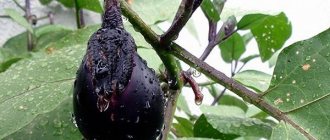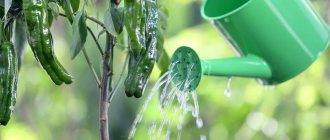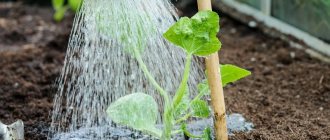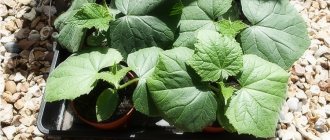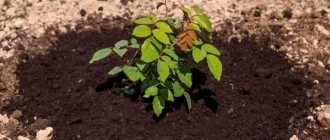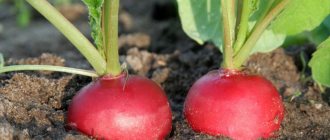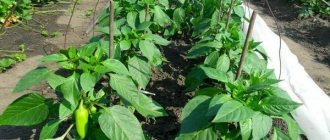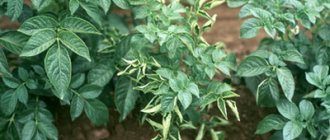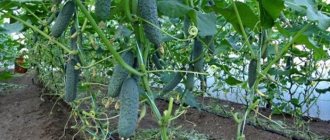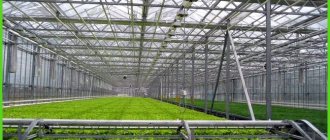Watermelons are a popular summer treat. Those who have a dacha or country house prefer to grow watermelon themselves rather than buy it at the market or in a store. To grow a large and tasty fruit, you need suitable soil, plenty of light and, of course, proper watering. By following the recommendations, you can grow a good harvest of melons.
- 2 How to determine that a watermelon needs to be watered
- 3 How often to water watermelon seedlings
- 4 How often to water watermelons in open ground
4.1 Table: irrigation regime for melons using drip irrigation when grown on medium loamy soils
- 5.1 Video: automation of watering using a drip irrigation system
5.2.1 Video: how to make a drip irrigation system with your own hands
How often do you need to water melons and what does it depend on?
The frequency and intensity of watering melons depends on what stage of growth the plant is in. Before the melons bloom, they do not need too much watering; approximately once every two days, about 3 liters of water should be poured under each bush. As soon as the period of active flowering begins, the plant requires another type of watering, in which its frequency is reduced to 2 times every 7 days, but the volume increases to 6 liters. After the flowers begin to transform into fruits, watering is carried out even less frequently, approximately once every 10 days, and more water will be required - from 10 to 12 liters for each planting. Before harvesting, watering stops altogether; this occurs within 10-14 days.
Planting watermelons for seedlings
In the center of Russia, in the east or north, you need to buy seeds of early varieties so that you can harvest in 70–90 days. Since in the Moscow region seedlings are planted in the ground at the end of May, late-ripening varieties do not have time to ripen. And for Siberia and the Urals, it is better to choose varieties that can withstand cold climates well.
Early variety of watermelons
Varieties of watermelons suitable for the center and north of Russia:
- Ultra-early Dyutina is a record holder for the timing of fruit appearance, ripening in 58–60 days. The plant is not large, has a small number of vines, each up to 2 m in length. Watermelons are scarlet inside. The pulp is granular and dense. The weight of the fetus is 4–6 kg. They are stored for about a month.
- Ultra-early ripening - also a record holder, the fruits ripen in 65–75 days. The plants are easy to care for and are not afraid of low temperatures. They are resistant to anthracnose and powdery mildew. Fruit weight is 1.5–3 kg. The taste of the pulp is sweet, it is grainy and tender. Collect 2.1 kg per 1 m².
- Charleston Gray - bred in France, he calmly tolerates the harsh climate of Siberia. The culture is powerful, a large number of long vines grow. Fetal weight up to 18 kg. The fruits are elongated in shape. The flesh is scarlet and very sweet. The variety is immune to diseases. Fruits can be stored for up to 1.5 months.
- Siberian Lights - ripening time 78–95 days. The variety is resistant to fusarium. Fruit weight is 1–2.4 kg. The pulp is sweet. It grows well in open areas because it can easily tolerate low temperatures.
- Ogonyok is easy to grow and is not afraid of cold weather. The variety is quite popular in Siberia. Fruits weighing approximately 2 kg. Watermelons have excellent taste.
- Astrakhan is another widely known and popular variety that is not afraid of cold weather. The fruits are large, weighing up to 6 kg. They keep well.
- Photon - from the appearance of sprouts to the ripening of watermelons, 82–105 days pass. Berry weight is 3–6 kg. The pulp has an excellent dessert taste. The bushes are resistant to anthracnose.
- Siberian Lights - 70–80 days pass from germination to berry picking. The bush is compact, canes up to 2.5 m. The pulp of the berries is juicy, scarlet, and sweet.
- Siberian - withstands the cold Siberian climate well. Berry weight is approximately 5 kg. The fruits have a sweet dessert taste.
- Sweet raspberry grows well both in Siberia and the Urals. Watermelons are small, weighing up to 1.5 kg. The pulp is sweet. Easy to care for.
Melon varieties that are suitable for the north and Moscow region:
- “ A Sybarite’s Dream ” - the harvest takes 50–55 days from emergence to harvest. Fruit weight 3 kg. It is pale yellow. The pulp is white, juicy, with a taste of honey. Up to 20 kg are collected from 1 m². The fruits ripen until frost. The variety is very resistant to pest attacks.
- “ Cappuccino ” - 2–2.5 months pass from the first shoots to the ripening of the fruit. The fruit is round or oval in shape. Berry weight is 0.8–1.5 kg. The pulp has an excellent dessert taste and contains 17% sugar. Up to 15 kg are collected from the bush.
- “ Cinderella ” - the period from germination to ripening of the berry is approximately 2–2.5 months. Long vines grow on the stem. The fruit is oval. Weight 1–2.5 kg. About 10–15 berries are removed from the bush.
- “ Golden ” - 72–87 days pass from germination to ripening of the berry. There are few vines on the stem. The melon is round or oval. Fruit weight up to 2 kg. It tastes like honey. 25 tons are harvested from 1 hectare. The berries can be transported.
- “ Sympathy ” - the fruits ripen in 100–108 days. Long vines grow on the stem. Fruit weight is 1.2–2 kg. Melon is oval. The pulp is sugary, very juicy. Up to 0.7 kg is collected from 1 m².
Melon variety Cappuccino
Advice! Buy seeds collected 2-3 years ago. If the seeds were collected recently, the bushes will produce many male flowers, but require female flowers to set berries.
Seed preparation
How to prepare watermelon and melon seeds for sowing:
- Make a mixture of half a glass of water and half a teaspoon of salt. Add the seeds.
- Throw away those that float to the surface, and select those that have fallen to the bottom of the glass, rinse in water, and dry.
- Place the seeds for 2–3 hours in clean water at 50–60°C.
- Next, pour the seeds into a weak solution of potassium permanganate for half an hour.
- Make a solution of Epin (growth stimulator): 4-6 drops in half a glass of water. Place the seeds in the solution for 18–24 hours.
- Then pour the seeds into water and wait for them to hatch.
Preparation of land and containers
To make a suitable soil, you need to mix 3 parts of humus, 1 part of turf. Another mixture is 6 parts of lowland peat, 2 parts of sawdust and 1 part of humus. Humus is needed so that the soil contains many nutrients for growth.
Land preparation
You can buy peat pots. Since peat is a natural substance, it also fertilizes the crop, the walls of the pot are porous, they easily allow moisture and oxygen to pass through, the roots can grow through the pots, they do not deform. When planting a plant in a peat pot, the roots are not damaged, as when transplanting from plastic.
Advice! You can buy peat tablets for seedlings, which contain elements useful for crops. But you need to place them in water so that they swell enough.
There is also a sowing method called “snail”: the soil is poured onto a long strip made of various materials. This strip, together with the soil, is carefully twisted like a roll.
Timing of sowing seeds
Growing watermelon seedlings begins in late March or early April. If you sow the seeds later, the seedlings will not grow by the date of transplantation to the site.
How to tell if melons need watering
There are several signs that indicate that a melon needs watering:
- seeds do not germinate;
- seedlings are weak, grow poorly and slowly;
- the bush looks stunted, the root system is weak and poorly developed;
- leaves wither, become deformed and fall off;
- too few ovaries are formed;
- The fruits are small and irregular in shape.
Selection of containers, soil preparation
Watermelons do not tolerate transplantation well, so seedlings need to be grown in such a way as to at least injure the root system of the plant. To do this, it is better to sow the seeds in peat pots, and then plant them in the ground together. In the ground, the peat pots will gradually soak and turn into fertilizer, and the plant will take root further.
Each seed is sown in its own pot.
The optimal diameter of the pots is 10-15 cm. A larger diameter of the pots is not needed, especially if the seedlings are planted not in peat pots, but in ordinary ones. When transplanting, the roots will occupy the entire space of the pot and such a plant can be carefully removed and replanted in the garden. Then the watermelon seedlings will take root better.
The soil for watermelons should be:
- fertile;
- preferably compost;
- slightly damp;
- best pH 6-7.
You can prepare the soil for growing seedlings yourself by mixing compost, garden soil and sand in a ratio (1:2:1).
General subtleties of watering melons
- To water melons, you need to use warm water, the temperature of which is not lower than 22 degrees. This will help moisture not only remain in the soil longer, but also prevent the occurrence of various putrefactive diseases.
- At each stage of plant development, the right amount of water is used, it varies from 3 to 10 liters.
- With the appearance of flowers on the bush, the melon is watered more often, and a smaller volume of water is used. It is recommended to stop watering in the first week after the first flowers appear; this measure will help reduce the number of empty flowers and increase the number of female flowers.
- You need to water the melon strictly into the ground, otherwise moisture that gets on the stem will cause rot.
- Plant leaves do not like liquid getting on them. In addition, drops of moisture in hot weather can cause burns.
- The area for watering plants should not be limited to the area near the root collar, since there are additional small roots on the vines that also need to be moistened.
Important! Melons do not need additional watering if the weather is rainy outside. Comfortable soil moisture for melon is 70%.
Seed preparation
A novice melon grower who wants to grow watermelons is always tempted to use the seeds of the most delicious purchased specimens in order to try to get the same wonderful fruits. Unfortunately, almost no one succeeds in this, since the best “striped berries” sold at the end of summer in the middle zone and more northern regions of the country, as a rule, come to the shelves from the Krasnodar Territory, the Lower Volga region and other areas with long warm summers. They are not suitable for cultivation in harsh climatic conditions. Seeds from store-bought imported watermelons, which are brought from China, Iran or Turkey in winter, are even less suitable for Russian gardens. Therefore, for your plot, it is better to buy seeds of specially bred varieties of the crop, characterized by early ripening, ease of care and rather modest fruit size. Of the varieties and hybrids included in the State Register of the Russian Federation, “Ogonyok”, “Gift of the Sun”, “Prince of Denmark F1”, “Siberian Lights”, “Sorento F1”, “Top Gun F1”, “Suga Baby” and some have such qualities other.
Manufacturers, as a rule, indicate information about zoning, that is, adaptability to the conditions of specific regions, on seed packages
According to experienced gardeners, the most successful harvests are obtained by using material collected 2-3 years before sowing. Last year's seeds produce plants that produce predominantly “male” flowers. The yield of such crops leaves much to be desired.
Separately, it is worth mentioning the seed collected from “our” plants in previous seasons. If the seeds are obtained from hybrid varieties, the economic characteristics of those specimens that grow from them will most likely not meet the owner’s expectations. When growing varietal watermelons, the problem of hybridization also exists. Representatives of this culture easily cross-pollinate not only with their “brothers” - watermelons, but also with their closest relatives - melons, pumpkins, zucchini and squash.
Taking into account the fact that pollinating insects can carry pollen over a distance of up to 20 km, the use of “our own” seeds obtained from varietal fruits is considered undesirable
Seeds must be prepared for sowing. To obtain uniform, even seedlings, the seed material is sorted (small specimens must be sown separately from large ones, since their germination times are different) and checked for germination by soaking for several minutes in a 5% solution of table salt (good seeds should “sink”). . Preparation consists of the following steps:
- Warming up . It is carried out to soften dense, hard skin. The procedure consists of soaking for 20-30 minutes in clean heated water at a temperature of 45-50 degrees. There is another method in which the material is kept on a warm, sunny windowsill for a week.
- Disinfection . The seeds are poured with a pink solution of potassium permanganate for 15-20 minutes, then taken out and dried in air, placed on a napkin.
- Germination . The material is wrapped in a wet cloth and left in a warm place at a temperature not lower than +30 ℃ until sprouts appear. Every day, the seeds are opened and ventilated, the fabric is moistened, preventing it from drying out.
Hatched seeds must be planted in the ground carefully so as not to break the sprouts
Some gardeners consider it necessary to carry out scarification (mechanical destruction of the shell) of seeds before all the work described. To do this, the hard skin is pierced, scored or scratched with a piece of sandpaper. However, experts do not have a consensus on the usefulness of such actions. There is even an opinion that scarification has a bad effect on the further development of plants and is therefore unacceptable.
Properly prepared seeds can be sown in about a week. The germination period increases if the temperature and humidity conditions were not maintained during the treatments. The entire complex of procedures increases the germination rate of the material to 99.9%.
Water for irrigation: a little more detail
Gardeners use different sources of water for irrigation. The main condition is to maintain a temperature regime in which the liquid used should not be below 22 degrees. Therefore, water from a well or water supply without preheating is absolutely not suitable for moistening the soil. It is best to pour water into a suitable large container in advance so that it heats up. Otherwise, the plant may become overcooled, the root system will become weak, and the melons themselves may develop various types of rot.
Watering melons must be properly combined with fertilizing. These plants love fertilizers that are applied directly to the soil in the form of a solution. If the usual rate of liquid during a specific period of planting growth is 7 liters, then the amount of fertilizing that you plan to apply should be subtracted from it. As a rule, this volume is about 1 liter. It is added to the soil in the evening after the sun's activity has decreased, while it is advisable to carry out regular watering early in the morning. Such simple mathematical calculations are carried out every time before feeding the melon, which allows you to avoid waterlogging of the soil and ensure maximum absorption of nutrients from the ground.
Growing seedlings at home
At home, it is recommended to grow watermelon seedlings in cups or peat tablets. In the first case, peat humus is prepared mixed with manure in a ratio of 1:0.2, and wood ash is added at the rate of 4 cups per 10 liters of soil mixture.
Be sure to make drainage holes in the cups and add a layer of drainage. For watermelons, you can use sawdust.
General seed preparation remains the same. The nuances lie in planting and further care. The seeds are placed in prepared, pre-moistened soil to a depth of 2-3 cm. Sprinkled with sand and covered with film until germination. The plantings are opened daily for ventilation and moderate spraying.
Attention: in order for the seeds to germinate faster, they must be planted sideways in the soil.
Rules for watering melons in a greenhouse
Melons prefer to grow where the air is quite dry; they do not tolerate excess moisture. Therefore, the proximity of other crops in the greenhouse should take this condition into account. For example, it is almost impossible to grow cucumbers and melons due to their different requirements for air quality. But tomatoes, peppers or eggplants will be excellent neighbors. Once the melons are planted in the greenhouse, they do not need additional watering for several days.
In the first days after planting the seedlings in the greenhouse, they will not require watering. It should be especially intense during the period when the plant’s ovaries are forming, which is when the liquid is needed for the normal development of the future crop. But as soon as the fruits grow the size of an orange, stop watering. Otherwise, the melon will be tasteless and bland.
Important! The absence of watering during the fruit ripening phase will give the melon a subtle sweet aroma and prevent deformation of the fruit.
In a greenhouse, plants need to be watered with very warm water, the temperature of which should be in the range from 30 to 33 degrees. Only in this way will evaporation be less intense and the moisture in the soil will remain longer.
When watering melons in a greenhouse, you should carefully ensure that water does not fall directly on the plantings themselves. Overmoistening them can provoke the formation of rot. Gardeners recommend using furrow irrigation, which is dug a short distance parallel to the main row of plantings. After flowering begins, the intensity of watering should be reduced, and all containers containing water should be removed from the greenhouse so that the air is not too humidified due to strong evaporation.
Watering melons is best done in the morning or evening hours, when the sun is not so active. Gardeners consider drip irrigation the best method for moistening the soil under a melon.
Important! When growing melon in a greenhouse, you need to periodically ventilate the room so that condensation does not appear on the walls and roof.
For better growth and development of plantings, once every 7 days you need to combine watering with the application of fertilizers, which are added to the soil at the root.
If you want to get tasty and aromatic fruits, you need to maintain a clear balance in watering and fertilizing. Only the correct care procedures for these plants, regardless of the method of growing them, will allow you to reap an excellent harvest.
Expert advice
Expert opinion
Kuznetsov Sergey Ivanovich
Expert on melons and melons
- After irrigation, it is recommended to loosen the soil and further mulch with grass. This will help retain moisture in the soil.
- It is better to water watermelons using a watering can without a nozzle; this method will protect the leaves from water and direct the stream directly to the root.
- Excess moisture during the formation of lashes can provoke the appearance of fungus.
- Drip irrigation allows you to accurately dose water-soluble fertilizers and makes fertilizing more convenient.
- Irrigation should be done strictly in accordance with the stages of plant growth.
Rules for watering melons in open ground
Beginning gardeners may mistakenly think that melon needs abundant watering, especially on hot days. But for them, excessive soil moisture is just as dangerous as drought. If the roots do not receive enough liquid, this will have a detrimental effect on the entire planting: the leaves will begin to wither, the flowers will fall off, and the fruits will crack and become deformed.
Important! Despite the fact that melon fruits contain the lion's share of moisture, there is no need to water the plants during their formation. Otherwise, it will have a detrimental effect on the taste of the crop.
When planting a melon, you need to prepare in advance for future watering. It is planted so that the bush is on a small hillock, around which a shallow ditch is dug. This is where liquid for watering or fertilizing will be poured. Plantings need to be moistened when there is no solar activity, for example, at dawn or after sunset. It is important to avoid dripping on the leaves and trunk, as well as on the base of the stem.
Important! If the weather outside is excessively hot, then the number of waterings should be increased to 2 times a day, dividing into morning and evening.
Plant roots go deep into the soil, so a dry surface layer of soil is not an indicator of the need for watering. Therefore, before watering, you need to dig up the soil a little and remove about 10 cm. If you find wet soil there, then watering can be postponed for a while. And if the soil does not stick together into a ball, then the bed needs to be moistened.
In the south of Russia, it is more advisable to use special irrigation systems; on an industrial scale, the water is not preheated, but due to the fact that the drops enter the soil one by one and are small in size, they heat up quickly enough and do not harm the roots.
In the central regions, it is better to use another method of irrigation - dig shallow grooves and pour warm water there.
In the table we have indicated the main watering parameters for different stages of plant development
| Parameter | Seedling | Before the flowers appear | Flowering phase | Fruit formation period |
| Liquid volume, l | From 0.1 to 0.5 l | About 3 l | From 5 to 7 l | From 10 to 12 l |
| Watering depth, cm | About 40 cm | 55 cm | 55 cm | 65 cm |
| Number of waterings | 1 time per day | 1 time every 2 days | 2 times per week | 1 time per week |
Your data is for normal temperature conditions typical for the region. But when it gets colder, rains or heat, the amount of watering needs to be adjusted.
Questions and answers
Is it possible to water watermelons directly from a hose?
This method is recommended to be used only for moistening the rows, since strong pressure can erode the soil in the holes and cause the leaves to come into contact with water.
Which irrigation method is suitable for large plantations?
The best option is drip irrigation. Using a special automated system, watering will be carried out for a certain time, measuring a set volume of water. The main advantage is the simultaneous watering of several plants.
How else can you check the degree of soil moisture?
Take a handful of soil from a depth of about 10 cm and try to form a ball out of the soil. A sticky structure indicates sufficient moisture, while a loose structure indicates a lack of moisture.
Is it possible to build a drip irrigation system using improvised materials?
It will not be possible to recreate an exact copy of the system, but a simpler similar design can be made. To do this, you will need several 10-liter plastic bottles without bottoms and lids. The bottles are immersed in the soil, neck down, and gradually filled with water. But such a homemade system does not guarantee high-quality results.
Is it possible to water greenhouse watermelons during the daytime?
It is necessary to water the plant early in the morning, or in the evening, after sunset, regardless of where it grows.
Proper watering of melons at different stages of development
Let's consider the features of watering a melon depending on the stage of its growth.
Melon in seedling stage
After emergence, seedlings of watermelons and melons should be watered frequently and sparingly. The main requirement is to prevent the soil in the pots from drying out without causing waterlogging.
The optimal soil moisture level should always be maintained within 50%. A week before transplanting into open ground, stop watering the seedlings.
Important! If it rains during the period after planting watermelon and melon seedlings, then watering is not carried out at all, and if cloudy weather without precipitation occurs, they are watered once a week.
Before transplanting into open ground, the area is moistened very generously. The humidity level should reach 90%. After 2 days, seedlings are planted.
After transplant
The first watering of plants is carried out 7 days after transplantation. It is carried out at the root using a watering can with a long “nose”. The frequency of adding water is every 2 days. Consumption per plant - 2 liters. If the soil is moist at the time of the next watering, reduce the frequency.
In the flowering stage
In the first days of flower formation, it is recommended to avoid watering. Then it is enough to irrigate the melons 1-2 times a week, pouring up to 7 liters of water under one plant. Attention! Gardeners often make the mistake during this period of watering watermelons and melons excessively. This leads to the formation of empty flowers and the falling of flowers.
Jpeg
During the formation of ovaries
Your crop has already grown and become a little stronger, but still requires additional care. At this stage, it is important to remember that you need not only to water the melon correctly, but also to carry out additional care measures. Watering rules remain unchanged compared to the previous stage. And additional care should consist of weeding weeds and loosening the soil to facilitate access of oxygen and water to the root system. As for weeds, they take away all the nutrients.
In the fruiting stage
At this stage, it is permissible to reduce watering. An already sufficiently developed root system will itself provide the plant with moisture, drawing it from the lower layers of the soil. It will be enough to water the melon once every 7 days, pouring at least 10 liters under one plant. It is very important to prevent water from getting on parts of the bush, especially the fruits, so that rot does not develop. When the fruits reach the desired size, it will be possible to stop moistening the soil altogether. Timely removal of weeds at this stage remains relevant.
Do watermelons need to be watered?
Watermelons need sufficient moisture throughout the growing season. The frequency of watering depends on the climate, soil type, and also affects the distance from natural and artificial reservoirs - it determines soil moisture.
- Watermelon grows best on loose sandy black soil. It is undesirable to grow melons on clay soils and flooded areas, since the development of a strong root system requires constant access to air. Dense soil must be plowed before planting.
- Sufficient illumination plays an important role. It is not recommended to plant watermelons in shaded areas, because a lack of light will significantly reduce the sugar content of the fruit and increase their ripening time.
- Melons are heat-loving plants and grow better in the subtropical geographical zone (for example, the southern regions of Ukraine and Russia) than in regions with a temperate climate. In regions with arid climates, regular watering is necessary from the time the seeds are sown until the fruiting period.
- It is generally accepted that watermelon is drought-resistant, but with insufficient watering, a weak plant with small fruits is formed.
For good watermelon growth, sufficient lighting and proper watering are important.
Frequency and intensity of watering melons for different irrigation methods
When growing the crops in question, you can use several irrigation methods:
- manual;
- into the rows from a hose;
- drip.
Important! After each watering, be sure to loosen the soil around the plants and between the rows to evenly distribute the liquid in its lower layers.
Manual
This method is suitable for those who grow very small quantities of fruit. This is done using a bucket or watering can. Water is poured under the root. The advantage of the method is the ability to control the amount of liquid entering the soil, as well as the complete elimination of the risk of moisture getting into the sinuses of the leaves. The disadvantage of such irrigation is the impossibility of its implementation over large areas.
When watering by hand - 2-3 liters per plant before flowering, then 7 liters during the flowering phase, then - 10-12 liters at intervals of once a week.
From the hose
Water is supplied from a hose into furrows 5 cm deep, made in the central part of the row spacing. The technique allows you to supply a large amount of water to a large area in a short time. The hose can be freely connected to any container that supplies water. In addition, this technique prevents water from entering the above-ground part of the plants.
When using a hose, add as much water at a time as is needed by all plants of a particular growing season growing in a row. For example, in a row there are 20 plants that have not yet entered the flowering phase. This means you need to supply 3 liters of water for each. Accordingly, 3×20=60 liters of water are needed for each row. The amount of water in subsequent phases of the growing season is calculated in the same way (see the amount for each plant in manual watering).
Drip
Recently, instead of manual watering (with a watering can or bucket under a bush) and from a hose, summer residents have been using the drip method of irrigating melons and melons. Its advantages: saving energy, time and water consumption; the soil does not erode under the bush; water does not get on parts of the plant; Fertilizers are applied simultaneously with watering. Such systems are bought in a store or built independently, connecting hoses to each bush. Irrigation is carried out as needed. Experienced gardeners turn on the system daily, in the morning or evening, for about an hour (regardless of the growing season). This gives each plant up to 1-2 liters of water.
Did you know? Melon peel, like watermelon peel, is used in cooking. It is used to make unique side dishes for various dishes and candied fruits.
How to grow watermelons with drip irrigation
The best way to water watermelons is drip irrigation. Advantages of this method:
- efficient use of water;
- lack of contact of water with leaves;
- the ability to dose watering;
- simplifying the application of fertilizers. There is no risk of damage to the stems and leaves;
- uniform watering;
- exception of soil erosion;
- saving the farmer's labor and time.
Factory-made drip irrigation systems are sold, consisting of a pump, a container, a supply pipe and a labyrinth of drip tapes. You can assemble a drip irrigation system yourself. To do this, a tap or automatic regulator is connected to the water supply line, a distribution system of plastic pipes is installed, to which a tape of droppers is connected. Droppers can be replaced with rubber hoses, in which holes are made after installation so that water flows to each plant.
Video: watering automation using a drip irrigation system
Drip irrigation principle
In case of irregular water supply, when making a drip irrigation system, use a large container, for example, a plastic barrel, which is filled as needed. The advantage of the barrel is that the water in it heats up for some time and watering is carried out with warm water.
Video: how to make a drip irrigation system with your own hands
A little about melon
Melon is a popular herbaceous annual. It has powerful roots extending 40 cm into the soil. The stem of the plant is branching, creeping, about 4 m long. The fruit is a false berry, the size of which depends on the variety and growing conditions. Melon seeds germinate a week after planting. The plant produces flowers of different sexes. In greenhouse conditions it needs pinching. The fruits complete development approximately a month after setting.
It requires light and heat; the optimal air temperature for growing is 25°C during the day and 19°C at night.
Loves space. Does not tolerate damp, shaded areas and lowlands. The optimal soil for growing good melons is light loam, black soil.
Important! The crop also develops well on sandy loam soils, but it also requires more water. After all, the light structure of the soil allows moisture to evaporate quickly enough.
Thanks to its long root, the plant is able to obtain moisture from a fairly large depth, so excessive watering is not required and is even contraindicated.
Appearance, collection and storage of seeds
The pulp of watermelon fruit contains many seeds. At the end of the growing season they ripen. Depending on the variety, the seeds vary in size, shape and color. Most often they are oval, flat, smooth or slightly grooved. The seeds are small, but slightly larger than melon seeds. They are usually uniformly colored, most often black-brown, less often gray, yellow or white.
The weight of 1000 watermelon seeds is 50-100 g. 1 g contains 10-20 seeds.
It is difficult to determine the ripeness of watermelon fruits, because ripe fruits do not differ from others - they do not soften, do not change color and do not emit a smell. You can recognize them only by the drying of the stems and tendrils next to them or by the slight cracking of the skin when squeezed with your hands. Ripe fruits are cut off with a sharp tool, leaving a stem 2 cm long.
The seeds are cut out by hand. They are placed on a strainer and washed thoroughly with running water. The drained seeds are allowed to dry completely in a dry, warm place. Properly dried and stored seeds remain viable for 5-6 years, sometimes 7-8 years from the moment of collection.
In the Moscow region, the Middle Belt, you can plant varieties - Sugar Baby, Photon, Yarilo, Gift of the Sun, Skorik, Crimson Sweet, Ogonyok, Raspberry. Grow until mid-June under film.
Seeds from the Leningrad company Biotechnika are being planted in St. Petersburg. Cultivation is carried out only in a greenhouse.
Tips and recommendations from experienced gardeners
How often to water eggplants in open ground
To get a sweet and large fruit, you should listen to the advice of experienced gardeners, who have been taught by time and will help you avoid the most common mistakes when caring for your plants. Further in the article are the most effective recommendations and advice, which are shared free of charge by experts in this matter:
- Bury a bottle with the top cut off next to each bush. Why do this? Everything is very simple. If you pour water into such a bottle, watering will become very effective, since moisture will flow into the soil evenly. The thing is that the soil takes as much water as it needs at a given stage. As soon as the container is empty, fill it with water again. This method will significantly save your time.
- In small areas, it is best to add at least two kilograms of humus to each hole. If this action is problematic for you, then fertilizing must be done directly during the growing season. This will contribute to the rapid growth of the fetus in the future.
- Don't forget about chasing bushes. When a bush throws out a lot of tops, it spends too much energy, which significantly slows down the growth of fruits and their formation.
- To make watermelons grow big, there is one secret that not all summer residents know. When the length of the first lashes of the bush reaches 1 meter, it is necessary to tear off the cones at their ends. In this case, the vines will produce side shoots, which will bear large fruits. This method is that if the growth of the vines is not stopped in time, there will be much more fruit, but the plant will not have enough strength to develop them, and the watermelons will turn out inferior.
- Excess moisture can cause the fruits to crack. Excess moisture is possible not only due to excessive watering; do not forget about rains, which can occur at the most inopportune moment. From time to time it is worth paying attention to the weather forecast. If the hydrometeorological center predicts rain, be sure to cover the beds with film. This primitive method will help to avoid excess moisture and help keep the fruit intact.
If we take into account all the wishes listed in the article, August will be fruitful and the farmer will definitely receive sweet and large fruits that will delight not only him, but also his loved ones.
3.3 4 votes
Article rating
